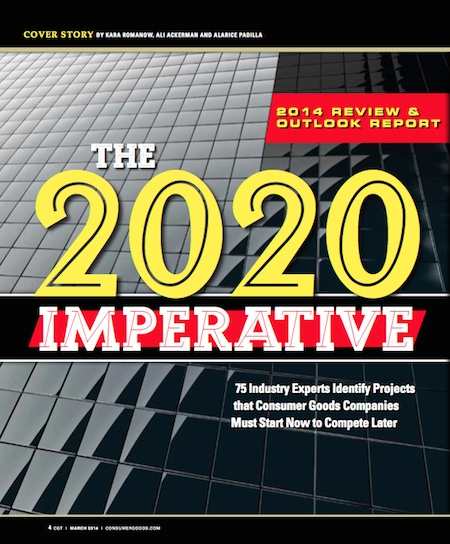Each year, Consumer Goods & Technology Magazine puts together an issue that peers into the future. I’ve been named one of their esteemed visionaries in the past, and again this year for their 2020 Imperative issue.
Here’s the opening comment from the magazine: any my insight is shared below that.
“It’s no secret that consumer goods companies must drastically change the way they do business in order to compete — and the pace of change needs to happen faster than ever before.
 Gone are the days of executing large-scale technology implementations at a leisurely pace. In 2014, consumer goods executives must often jump head first into new initia-tives — like big data, digital marketing and omnichannel selling — without much of a safety net to protect their brands, businesses or investments. That’s the exciting, yet challenging, world we live and work in today.
Gone are the days of executing large-scale technology implementations at a leisurely pace. In 2014, consumer goods executives must often jump head first into new initia-tives — like big data, digital marketing and omnichannel selling — without much of a safety net to protect their brands, businesses or investments. That’s the exciting, yet challenging, world we live and work in today.
But, what about five or 10 years from now? How can consumer goods companies best prepare themselves to stay in front of future trends, many of which are just educated
guesses at this point?
In the 2014 Review & Outlook Report, we asked 75 of
the industry’s brightest minds — each of whom is driving change in the consumer goods industry in his or her own right — to look into their crystal ball and tell us:
“What one initiative must consumer goods companies pursue now in order to compete and grow in the year 2020?”
Jim Carroll’s observations
Going forward, the biggest trend impacting the consumer goods and retail sector is that the pace of innovation has clearly shifted to the speed dictated by Silicon Valley — which means that the innovation will now occur at the speed of Moore’s law.
(Remember, Moore’s law explains that roughly, the processing power of a computer chip doubles every 18 months while its cost cuts in half. It provides for the pretty extreme exponential growth curve we see with a lot of consumer and computer technology today.)
The checkout process? It’s now being driven at hyper-speed through the introduction of iPad-enabled checkout devices, which accelerates change.
The introduction of ever more intelligent, connected packaging technologies shifts control of innovation from traditional packaging companies to tech companies, the makers of bits and chips and RFID and tags.
In store interaction, with consumers more engaged with their iPhone than with a salesperson, now evolve at staggering speed as in-store promotion technologies no longer involve cool cardboard box end-cap displays, but hi-tech LED televisions wired to Facebook Like buttons.
And of course, there’s the Amazon helicopter drone delivery system. Science fiction? Maybe so — but if you think so, then I suggest you watch a few old episodes of The Jetson’s cartoon show. Watch carefully, and you’ll see that George was actually having FaceTime chats, read his news off the Internet, and has Internet-sensor, connected clothing. What was once sci- ence fiction now becomes reality faster than ever before.
This means that in the future, the consumer goods industry is going to have to learn to innovate at the speed of companies such Apple, Google, Twitter and Facebook, as opposed to a more leisure- ly pace of innovation found in the past. Clearly, Moore’s law rules! Hence, my catchphrase — the future belongs to those who are fast!




GET IN TOUCH
Jim's Facebook page
You'll find Jim's latest videos on Youtube
Mastodon. What's on Jim's mind? Check his feed!
LinkedIn - reach out to Jim for a professional connection!
Flickr! Get inspired! A massive archive of all of Jim's daily inspirational quotes!
Instagram - the home for Jim's motivational mind!